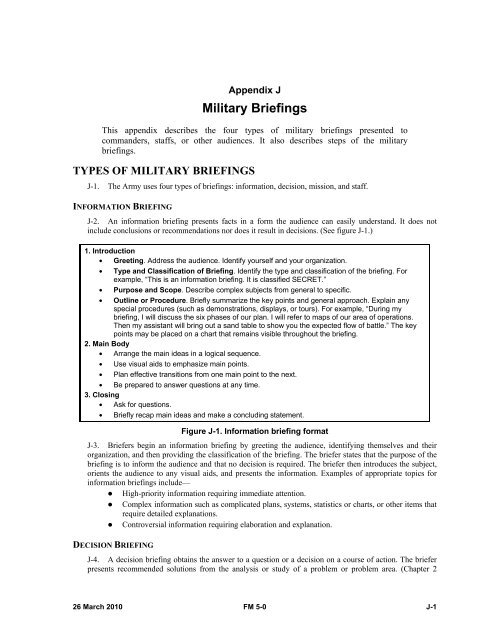FM 5-0, The Operations Process - Federation of American Scientists
FM 5-0, The Operations Process - Federation of American Scientists
FM 5-0, The Operations Process - Federation of American Scientists
You also want an ePaper? Increase the reach of your titles
YUMPU automatically turns print PDFs into web optimized ePapers that Google loves.
Appendix J<br />
Military Briefings<br />
This appendix describes the four types <strong>of</strong> military briefings presented to<br />
commanders, staffs, or other audiences. It also describes steps <strong>of</strong> the military<br />
briefings.<br />
TYPES OF MILITARY BRIEFINGS<br />
J-1.<br />
<strong>The</strong> Army uses four types <strong>of</strong> briefings: information, decision, mission, and staff.<br />
INFORMATION BRIEFING<br />
J-2. An information briefing presents facts in a form the audience can easily understand. It does not<br />
include conclusions or recommendations nor does it result in decisions. (See figure J-1.)<br />
1. Introduction<br />
• Greeting. Address the audience. Identify yourself and your organization.<br />
• Type and Classification <strong>of</strong> Briefing. Identify the type and classification <strong>of</strong> the briefing. For<br />
example, “This is an information briefing. It is classified SECRET.”<br />
• Purpose and Scope. Describe complex subjects from general to specific.<br />
• Outline or Procedure. Briefly summarize the key points and general approach. Explain any<br />
special procedures (such as demonstrations, displays, or tours). For example, “During my<br />
briefing, I will discuss the six phases <strong>of</strong> our plan. I will refer to maps <strong>of</strong> our area <strong>of</strong> operations.<br />
<strong>The</strong>n my assistant will bring out a sand table to show you the expected flow <strong>of</strong> battle.” <strong>The</strong> key<br />
points may be placed on a chart that remains visible throughout the briefing.<br />
2. Main Body<br />
• Arrange the main ideas in a logical sequence.<br />
• Use visual aids to emphasize main points.<br />
• Plan effective transitions from one main point to the next.<br />
• Be prepared to answer questions at any time.<br />
3. Closing<br />
• Ask for questions.<br />
• Briefly recap main ideas and make a concluding statement.<br />
Figure J-1. Information briefing format<br />
J-3. Briefers begin an information briefing by greeting the audience, identifying themselves and their<br />
organization, and then providing the classification <strong>of</strong> the briefing. <strong>The</strong> briefer states that the purpose <strong>of</strong> the<br />
briefing is to inform the audience and that no decision is required. <strong>The</strong> briefer then introduces the subject,<br />
orients the audience to any visual aids, and presents the information. Examples <strong>of</strong> appropriate topics for<br />
information briefings include—<br />
• High-priority information requiring immediate attention.<br />
• Complex information such as complicated plans, systems, statistics or charts, or other items that<br />
require detailed explanations.<br />
• Controversial information requiring elaboration and explanation.<br />
DECISION BRIEFING<br />
J-4. A decision briefing obtains the answer to a question or a decision on a course <strong>of</strong> action. <strong>The</strong> briefer<br />
presents recommended solutions from the analysis or study <strong>of</strong> a problem or problem area. (Chapter 2<br />
26 March 2010 <strong>FM</strong> 5-0 J-1















